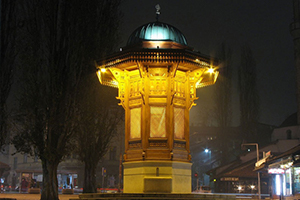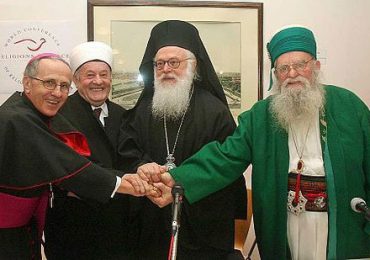Bosnia & Herzegovina is a small country in Southeastern Europe, in the Balkans peninsula. The area that the country occupies today has been inhabited since Neolithic age but the most important populations have been those of Illyrians and the Celts. As the rest of the Balkans, even this area has been part of Roman Empire, has been a region of disputes in the Byzantine Empire, has had quite a few kingdoms and rulers in the Middle Ages and has also been part of the Ottoman Empire. All this mixture, has left its traces giving us today a great combination of cultures in Bosnia. And this is without the last century. The 20thcentury for this part of Europe has been one of the most eventful, considering that the First World War began here and other conflicts related to the Yugoslav Republic. The footnotes of history and culture that we see today, and that you will see starting from today, are the treasure of Bosnia.
But there is not just history in Bosnia. The people in Bosnia show off with righteousness about their hinterland. Despite the fact that the country has only some 20 kilometers of sea shore, considered as the Bosnian kiss to the Adriatic, the country does not lack other beauties. The inland are a mosaic of crystal blue waters combined with emerald green mountains and their snowy peaks.
It is no wonder that Bosnia is called the heart of Europe, for not just it’s location and area shape, but also hiding inside some of Europe’s wonders. That is why we have created tours in Bosnia & Herzegovina.
Facts
Population: 3.5 million | Capital: Sarajevo | Language: Bosnian, Croatian, Serbian | Surface: 51,197 km2
 The name Sarajevo is a slavilization of the words in Turkish for “the place of the governor” (the saray) and it’s nicknames include Damascus of the North and the European Jerusalem. In the antiquity the area was ruled by Illyrians and the Butmir culture was wide spread. The Roman Empire had the area as part of it and as the rest of the Balkans, even Sarajevo was part of the Slavic invasions. The Ottomans established the town in the 15th century and the governor himself lived in the center of the city. This is the reason why it was called Sarajevo. It had typical Ottoman architecture in the buildings, in the market and it was one of the most important of the area, serving also as a capital of vilayet. In the beginnings of the 20th century, the country and Sarajevo itself was part of the Austro-Hungarian Empire and this time was a glorious one of Sarajevo because the city took another face, an European one. It became very famous after the assassination in the bridge of Archduke Fraz Ferdinand that set up the start of WWI. Afterwards it became part of Yugoslavia and then it became the capital of Bosnia & Herzegovina.
The name Sarajevo is a slavilization of the words in Turkish for “the place of the governor” (the saray) and it’s nicknames include Damascus of the North and the European Jerusalem. In the antiquity the area was ruled by Illyrians and the Butmir culture was wide spread. The Roman Empire had the area as part of it and as the rest of the Balkans, even Sarajevo was part of the Slavic invasions. The Ottomans established the town in the 15th century and the governor himself lived in the center of the city. This is the reason why it was called Sarajevo. It had typical Ottoman architecture in the buildings, in the market and it was one of the most important of the area, serving also as a capital of vilayet. In the beginnings of the 20th century, the country and Sarajevo itself was part of the Austro-Hungarian Empire and this time was a glorious one of Sarajevo because the city took another face, an European one. It became very famous after the assassination in the bridge of Archduke Fraz Ferdinand that set up the start of WWI. Afterwards it became part of Yugoslavia and then it became the capital of Bosnia & Herzegovina. The area around Mostar is well known as an ancient settlement but the town of Mostar is firstly mentioned in the Middle Ages, even though there is found an old Christian basilica. In the 15th century the town was established in both sides of a bridge, and from the word Mostar (meaning bridge-keepers) was given to the place there. Nearby there were two other small towns in the area and along with Mostar, they were all part of Ottoman Empire and Mostar developed as a town between the Adriatic and the rich central Bosnia. As most of Ottoman cities, Mostar was developed and took the appearance of a typical Ottoman city, which is still visible today. It was part of Ottoman Empire until the Bosnian people got their independence from the Ottomans. The whole road to Mostar is wonderful itself with some stunning nature attractions and then the history kicks in when you cross the Old Bridge in Mostar.
The area around Mostar is well known as an ancient settlement but the town of Mostar is firstly mentioned in the Middle Ages, even though there is found an old Christian basilica. In the 15th century the town was established in both sides of a bridge, and from the word Mostar (meaning bridge-keepers) was given to the place there. Nearby there were two other small towns in the area and along with Mostar, they were all part of Ottoman Empire and Mostar developed as a town between the Adriatic and the rich central Bosnia. As most of Ottoman cities, Mostar was developed and took the appearance of a typical Ottoman city, which is still visible today. It was part of Ottoman Empire until the Bosnian people got their independence from the Ottomans. The whole road to Mostar is wonderful itself with some stunning nature attractions and then the history kicks in when you cross the Old Bridge in Mostar. One of the top spots in the inner lands of Bosnia, just in the border with Serbia, is Visegrad. Emerging as an important trade city in the Middle Ages under the rule of the Serbian emperor, Stefan Dusan, Visegrad quickly grew to be one of the most important cities of the province of eastern Bosnia. It’s continuous importance is especially noticed in one of it’s most special attractions: Mehmed Paša Sokolović Bridge, build during the rule of Ottoman Empire in 1577. The bridge offers a stunning view over the Driva River, with it’s panoramic banks and it has been featured in the Noble winning book, The Bridge on the Drina. Besides this UNESCO Heritage object, Visegrad is also one of the cities where you can feel and see the most of one of the darkest pages of Balkans, the Bosnian War.
One of the top spots in the inner lands of Bosnia, just in the border with Serbia, is Visegrad. Emerging as an important trade city in the Middle Ages under the rule of the Serbian emperor, Stefan Dusan, Visegrad quickly grew to be one of the most important cities of the province of eastern Bosnia. It’s continuous importance is especially noticed in one of it’s most special attractions: Mehmed Paša Sokolović Bridge, build during the rule of Ottoman Empire in 1577. The bridge offers a stunning view over the Driva River, with it’s panoramic banks and it has been featured in the Noble winning book, The Bridge on the Drina. Besides this UNESCO Heritage object, Visegrad is also one of the cities where you can feel and see the most of one of the darkest pages of Balkans, the Bosnian War. Medjugorje is a small town close to the border with Croatia with most of the population Croatian. It is not a town that you can do many activities but is one of the places considered as most holy in Balkans because of the apparition of Virgin Mary to 6 local Christians since 1981. This phenomena has been investigated by local bishops and the Vatican itself but nevertheless, the locals have build quite a few places to worship Mary, places that you will visit today. The walk starts firstly to the Holy Place, the place where Mary first appeared. Continuing, you will visit the Statue of Saint Mary and the church of Saint James, a saint from the 19th century. Throughout the whole city you will have a feel of divine harmony and certainly will feel calmer.
Medjugorje is a small town close to the border with Croatia with most of the population Croatian. It is not a town that you can do many activities but is one of the places considered as most holy in Balkans because of the apparition of Virgin Mary to 6 local Christians since 1981. This phenomena has been investigated by local bishops and the Vatican itself but nevertheless, the locals have build quite a few places to worship Mary, places that you will visit today. The walk starts firstly to the Holy Place, the place where Mary first appeared. Continuing, you will visit the Statue of Saint Mary and the church of Saint James, a saint from the 19th century. Throughout the whole city you will have a feel of divine harmony and certainly will feel calmer. The legislation of Bosnia and Herzegovina recognises three constituent peoples and 17 national minorities which is about 2.73% of the total population of the country.About 97% of population of Bosnia and Herzegovina consists of three autochthonous constituent nations ; bosniak, serbs and croats. Bosnia & Herzegovina’s cultural groups consist of 50.70% identified as Muslim, 30.75% identified as Orthodox Christians, and 15.19% identified as Roman Catholic Christians. Bosnians have always been very tolerant and accepting of religious difference.Almost every bosnian is open minded. It is common in Bosnia-Herzegovina for neighbours to visit each other during Christmas or Ramadan no matter what their religion is.
The legislation of Bosnia and Herzegovina recognises three constituent peoples and 17 national minorities which is about 2.73% of the total population of the country.About 97% of population of Bosnia and Herzegovina consists of three autochthonous constituent nations ; bosniak, serbs and croats. Bosnia & Herzegovina’s cultural groups consist of 50.70% identified as Muslim, 30.75% identified as Orthodox Christians, and 15.19% identified as Roman Catholic Christians. Bosnians have always been very tolerant and accepting of religious difference.Almost every bosnian is open minded. It is common in Bosnia-Herzegovina for neighbours to visit each other during Christmas or Ramadan no matter what their religion is.